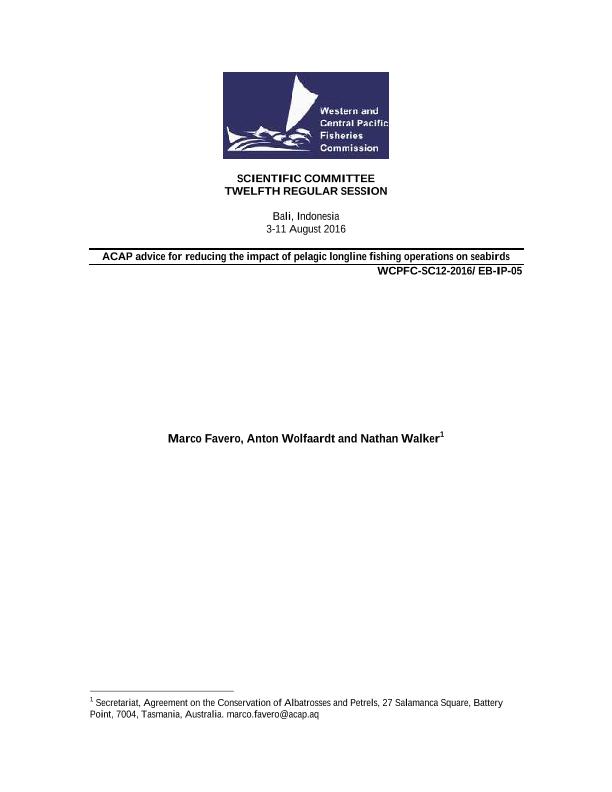Mostrar el registro sencillo del ítem
dc.contributor.author
Favero, Marco

dc.contributor.author
Wolfaardt, Anton
dc.contributor.author
Walker, Nathan
dc.date.available
2022-04-06T10:08:18Z
dc.date.issued
2020
dc.identifier.citation
ACAP advice for reducing the impact of pelagic longline fishing operations on seabirds; 12th Regular Session of the Scientific Committee; Pohnpei; Micronesia; 2016; 1-11
dc.identifier.uri
http://hdl.handle.net/11336/154474
dc.description.abstract
The incidental mortality of seabirds, mostly albatrosses and petrels, in longline fisheries continues to be aserious global concern and was the major reason for the establishment of the Agreement on theConservation of Albatrosses and Petrels (ACAP). In longline fisheries seabirds are killed when theybecome hooked and drowned while foraging for baits on longline hooks as the gear is deployed. Theyalso can become hooked as the gear is hauled, although many of these seabirds can be released alive withcareful handling. ACAP routinely reviews the scientific literature regarding seabird bycatch mitigation infisheries, and on the basis of these reviews updates its best practice advice. The most recent review wasconducted in May 2016 at ACAP´s Seabird Bycatch Working Group and Advisory Committee meetings(ACAP 2016), and this document presents a distillation of that review for the consideration of theWCPFC Scientific Committee. A combination of weighted branch lines, bird scaring lines and nightsetting remains the best practice approach to mitigate seabird bycatch in pelagic longline fisheries.Changes in this regard only applied to the recommended minimum standards for line weighting regimes,now updated to the following configurations: (a) 40 g or greater attached within 0.5 m of the hook; or (b)60 g or greater attached within 1 m of the hook; or (c) 80 g or greater attached within 2 m of the hook. Inaddition, ACAP endorsed the inclusion in the list of best practice measures of two hook-shielding devicesas stand-alone mitigation measures. Such hook-shielding devices encase the point and barb of baitedhooks until a prescribed depth or time immersed to prevent seabird becoming hooked during line setting.The following performance requirements were used by ACAP to assess the efficacy of hook-shieldingdevices in reducing seabird bycatch: (a) the device shields the hook until a prescribed depth of 10 m orimmersion time of 10 minutes is reached; (b) the device meets current recommended minimum standardsfor branch line weighting; and (c) experimental research has been undertaken to allow assessment of theeffectiveness, efficiency and practicality of the technology against the ACAP best practice seabird bycatchmitigation criteria. ACAP recognizes that factors such as safety, practicality and the characteristics of thefishery should also be taken into account when considering the efficacy of seabird bycatch mitigationmeasures and consequently in the development of advice and guidelines on best practice.
dc.format
application/pdf
dc.language.iso
eng
dc.publisher
Western and Central Pacific Fisheries Commission
dc.rights
info:eu-repo/semantics/openAccess
dc.rights.uri
https://creativecommons.org/licenses/by-nc-sa/2.5/ar/
dc.subject
Pelagic longline
dc.subject
Seabird bycatch
dc.subject
RFMOs
dc.subject.classification
Ciencias Medioambientales

dc.subject.classification
Ciencias de la Tierra y relacionadas con el Medio Ambiente

dc.subject.classification
CIENCIAS NATURALES Y EXACTAS

dc.title
ACAP advice for reducing the impact of pelagic longline fishing operations on seabirds
dc.type
info:eu-repo/semantics/publishedVersion
dc.type
info:eu-repo/semantics/conferenceObject
dc.type
info:ar-repo/semantics/documento de conferencia
dc.date.updated
2022-03-17T14:06:54Z
dc.journal.pagination
1-11
dc.journal.pais
Micronesia

dc.journal.ciudad
Pohnpei
dc.description.fil
Fil: Favero, Marco. Consejo Nacional de Investigaciones Científicas y Técnicas. Centro Científico Tecnológico Conicet - Mar del Plata. Instituto de Investigaciones Marinas y Costeras. Universidad Nacional de Mar del Plata. Facultad de Ciencias Exactas y Naturales. Instituto de Investigaciones Marinas y Costeras; Argentina
dc.description.fil
Fil: Wolfaardt, Anton. No especifíca;
dc.description.fil
Fil: Walker, Nathan. No especifíca;
dc.relation.alternativeid
info:eu-repo/semantics/altIdentifier/url/https://www.iotc.org/fr/documents/WPEB/15/41
dc.relation.alternativeid
info:eu-repo/semantics/altIdentifier/url/https://meetings.wcpfc.int/meetings/sc12
dc.relation.alternativeid
info:eu-repo/semantics/altIdentifier/url/https://meetings.wcpfc.int/node/9598
dc.conicet.rol
Autor

dc.conicet.rol
Autor

dc.conicet.rol
Autor

dc.coverage
Internacional
dc.type.subtype
Reunión
dc.description.nombreEvento
12th Regular Session of the Scientific Committee
dc.date.evento
2016-08-03
dc.description.ciudadEvento
Pohnpei
dc.description.paisEvento
Micronesia

dc.type.publicacion
Journal
dc.description.institucionOrganizadora
Western and Central Pacific Fisheries Commission
dc.source.revista
12th Regular Session of the Scientific Committee
dc.date.eventoHasta
2016-08-11
dc.type
Reunión
Archivos asociados
